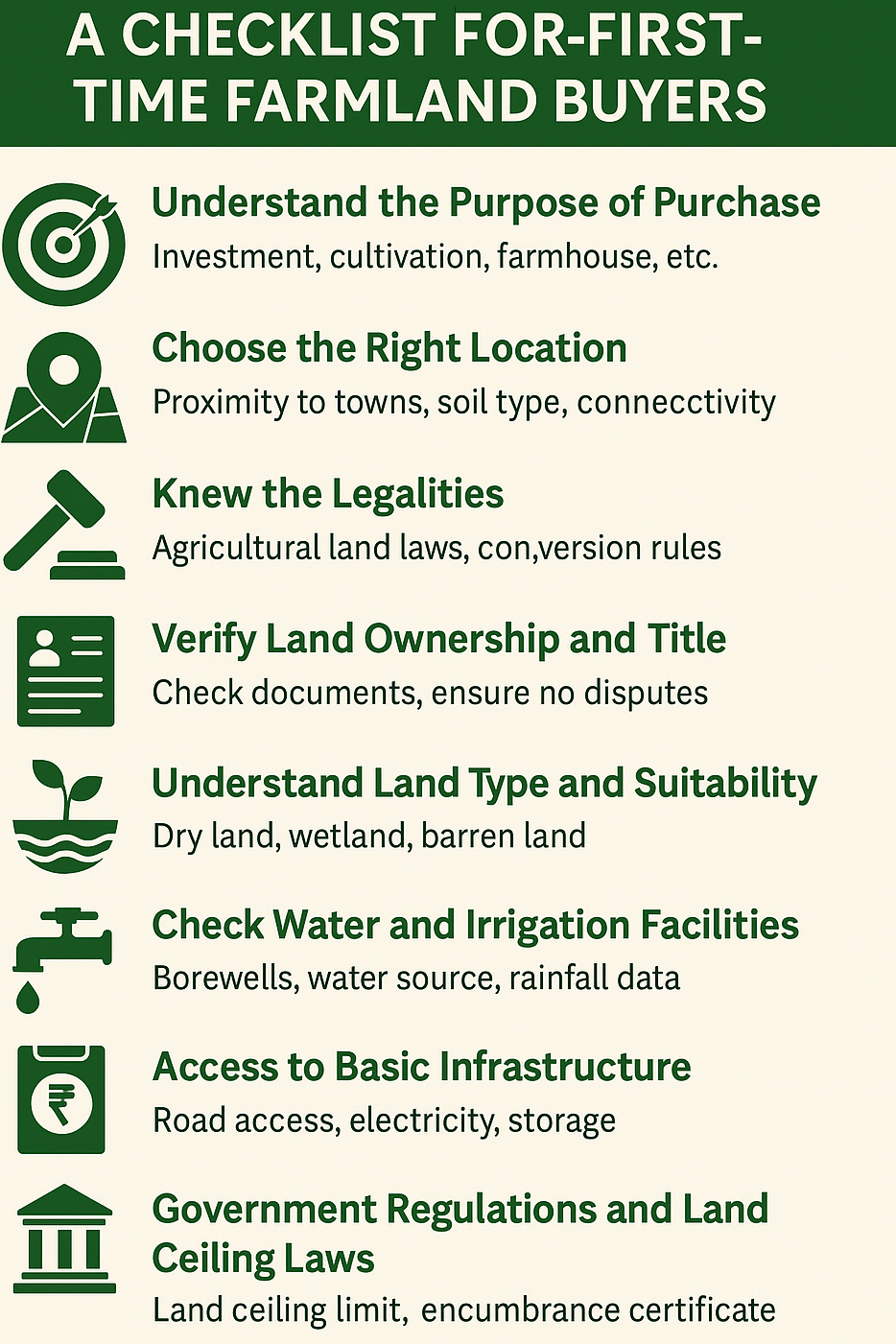Index
- Buy Farmland Understanding the Purpose
- Choose the Right Location
- Know the Legalities Before You Buy Farmland
- Verify Land Ownership and Title
- Understand Land Type and Suitability
- Check Water and Irrigation Facilities
- Access to Basic Infrastructure
- Budget and Financial Planning To Buy Farmland
- Government Regulations and Land Ceiling Laws
- Consider Future Resale or Development Value
- Final Tips to Buy Farmland Safely
- Final Thoughts
- Have a look!
1. Buy Farmland- Understanding the Purpose
Your purpose to buy farmland will determine the kind of land you need. Before you begin searching for farmland, know exactly why you are buying it.
- Investment purpose: If your goal is future resale or appreciation, look for land near developing areas.
- Farming or cultivation: You’ll need fertile soil, water access, and agricultural zoning.
- Farmhouse construction: You’ll need residential permissions and legal conversion from agricultural to residential land.
- Commercial use (like farm stays): You need land close to tourist areas with proper road access.
🔹 Example: 60% of new farmland buyers in India prefer farmland for investment and rental income, not farming (Economic Times, 2024).
2. Choose the Right Location
Location impacts price, productivity, and future value. Look for areas with good growth potential and climate suitability.
- Proximity to towns or cities: Easier access to markets and transportation.
- Climate and rainfall: Ensure the region supports the crops you want to grow.
- Soil type: Different crops require different soil types – check local agriculture reports.
- Connectivity: Well-connected roads help in transporting goods and equipment.
🔹 Top locations for farmland investment in 2025:
- Pune outskirts (Maharashtra)
- Sonipat and Jhajjar (Haryana)
- Dausa and Alwar (Rajasthan)
- Nainital foothills (Uttarakhand)
3. Know the Legalities Before You Buy Farmland
Understanding the legal framework of agricultural land is essential to avoid future problems.
- Agricultural land purchase laws differ across states. Some restrict non-farmers from buying farmland (e.g., Karnataka).
- Land use classification: Make sure the land is categorized as agricultural.
- Conversion restrictions: In some states, converting agricultural land into residential or commercial is restricted.
🔹 Tip: Always consult a local lawyer who understands land laws in that state.
4. Verify Land Ownership and Title
Land disputes are common, so title verification is crucial.
- Request and check the 7/12 extract or Jamabandi record. This document lists owner details and past transactions.
- Ask for the latest tax receipts and utility bills.
- Ensure the land is not under litigation or acquired by the government.
- If inherited land, verify proper partition among heirs.
🔹 Case Study: In 2023, 1 in every 5 farmland transactions in India faced ownership disputes due to improper documentation (Land Ministry Data).
5. Understand Land Type and Suitability To Buy Farmland
Not all agricultural land is suitable for the same type of use. Learn about its classification.
- Dry land: Suitable for hardy crops like millet or pulses.
- Wetland: Used for rice or sugarcane.
- Barren or uncultivable land: May require heavy investment for improvement.
- Sloped land: Might need terracing or soil treatment for farming.
🔹 Tip: Get a soil test done from a local Krishi Vigyan Kendra (KVK) or private lab.
6. Check Water and Irrigation Facilities
Water access is one of the most critical factors for farmland success.
- Check for availability of borewells or canals.
- Distance to the nearest water source: Affects irrigation cost.
- Water quality: Saline or contaminated water can damage crops.
- Rainfall data: Understand the area’s monsoon pattern.
🔹 Fact: According to NABARD, irrigation-supported land gives 2.5x more return than dry land in most regions.
7. Access to Basic Infrastructure
The surrounding infrastructure can increase land productivity and value.
- Access roads and approach paths: Essential for daily operations and transport.
- Availability of electricity: Needed for water pumps and tools.
- Storage and market access: Selling produce locally or through mandis becomes easier.
🔹 Consider: How close is the nearest village, market, petrol station, and bank?
8. Budget and Financial Planning To Buy Farmland
Have a clear budget plan, including hidden costs and ongoing expenses.
- Land cost: Price per acre varies widely from ₹2 lakh/acre in some areas to ₹50 lakh/acre near cities.
- Registration charges and stamp duty: Typically 5–7% of land value.
- Land improvement cost: Fencing, levelling, borewell drilling, etc.
- Maintenance cost: Hiring help, irrigation, fertilizers, etc.
🔹 Tip: Apply for farm loans or schemes under NABARD or PM-KISAN if eligible.
9. Government Regulations and Land Ceiling Laws
Every state in India has land ceiling limits—how much land one person or family can hold.
- Check your state’s land ceiling limit. Exceeding it could lead to cancellation of ownership.
- Land reforms: Some states prohibit companies or non-agriculturists from buying agricultural land.
- Encumbrance Certificate: This ensures the land has no financial or legal liabilities.
🔹 Data: In Rajasthan and Madhya Pradesh, the limit is around 18 to 25 acres per family unit.
10. Consider Future Resale or Development Value
Even if youa buy for farming now, think about its future resale potential.
- Land near highways or new infrastructure projects appreciates faster.
- Check if land is part of a notified development plan.
- Proximity to industrial zones or tourist areas increases rental or resale value.
- Ensure your land is not falling under green belt or conservation zones.
🔹 Smart strategy: Look for farmland in areas included in the state’s regional development plans.
11. Final Tips to Buy Farmland Safely
Here are a few final tips to protect your interests when buying farmland:
- Avoid cash transactions. Always pay via bank and keep receipts.
- Hire a local agricultural expert or land agent with a good reputation.
- Document everything, including agreements with previous owners or brokers.
- Ask neighbors about land history—they often reveal facts the seller won’t.
🔹 Pro tip: Use satellite land verification tools like Bhunaksha or Bhuvan to check plot coordinates and status.
Final Thoughts
Buying farmland for the first time is a big decision that goes beyond the land’s price. It involves careful evaluation of soil, water, legal papers, and long-term usability. Use this checklist to avoid costly mistakes and make an informed investment. Whether you’re planning to grow crops, build a farmhouse, or invest for the future, the right farmland can offer both peace of mind and strong returns.




